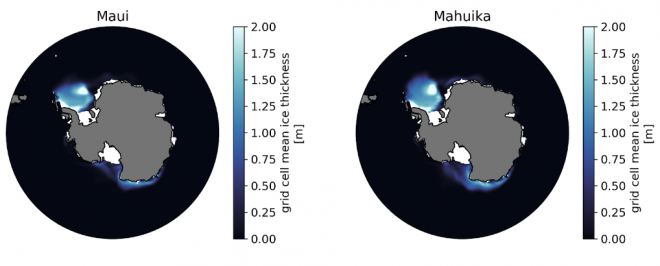Enabling portability of a climate code through containerisation
The below case study shares some of the technical details and outcomes of the scientific and HPC-focused programming support provided to a research project through NeSI’s Consultancy Service.
This service supports projects across a range of domains, with an aim to lift researchers’ productivity, efficiency, and skills in research computing. If you are interested to learn more or apply for Consultancy support, visit our Consultancy Service page.
Research background
The NZESM is the New Zealand earth system model, which has been developed as part of the Deep South National Science Challenge.
A goal of the challenge is to better understand the climate change drivers in the south Pacific region. Some of that work is making its way onto improved representation of freezing nuclei in the Unified Model (UM).
Project challenges
Providing a portable solution of the executables (UM and dependencies) will make it easier for the model to be used in the future both for science and teaching, and maintain reproducibility of the models for the future.
What was done
NeSI worked with University of Otago researcher Andrew Pauling to provide a portable UM executable, which can run on any recent Linux and future platforms. As part of this project:
- A container was built with the necessary compilers and libraries needed to build the model, as well as scripts needed to access the proprietary components of the model that could not be included in the public container.
- Configuration files were written for the model to allow it to be built using the compilers and libraries inside the container
- The container was setup to use the Slurm scheduling softwater on the host machine, not inside the container, to allow us to take advantage of the preconfigured scheduler on the host machine.
Main outcomes
Andrew and his collaborators now can successfully build and run the UM on systems other than the Maui supercomputer, future-proofing their work for eventual migration to new platforms.
Researcher feedback
"The outcome of this project - a portable version of the main model used in my research - will be critical as NeSI refreshes its platforms in the future. The support from The NeSI team, in particular Alex Pletzer, was crucial to achieving this goal. This will allow me to continue conducting state-of-the-art climate model simulations in New Zealand irrespective of any changes to future HPC platforms. This project also gave me the opportunity to become much more familiar with the infrastructure and software underlying the model, which will also be valuable experience for the future."
- Dr Andrew Pauling, Research Fellow, Department of Physics, University of Otago | Ōtākou Whakaihu Waka
Do you want to bring your research to the next level? We can help. Send an email to support@nesi.org.nz to learn more about our Consultancy support or visit our Consultancy Service page.







